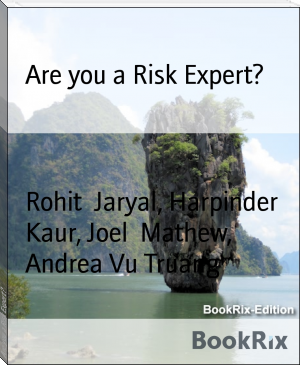Are you a Risk Expert? - Rohit Jaryal, Harpinder Kaur, Joel Mathew, Andrea Vu Truang (bill gates book recommendations txt) 📗

- Author: Rohit Jaryal, Harpinder Kaur, Joel Mathew, Andrea Vu Truang
Book online «Are you a Risk Expert? - Rohit Jaryal, Harpinder Kaur, Joel Mathew, Andrea Vu Truang (bill gates book recommendations txt) 📗». Author Rohit Jaryal, Harpinder Kaur, Joel Mathew, Andrea Vu Truang
We need to identify the situation, what is happening
Determine who and what is going to harm
Determine the adequate actions for this hazard
Evaluate that controllable measure that it is right one to mitigate or eliminate the risk
Review the risk assessment again to confirm assessment is right.
Documents which is needed for risk assessment-
Risk involved list
Historical data
Legal data and requirements
Prevention measures list for risks
Risk MetricsFigure 4: Value Map Showing Risk Evolution (Bugalla, J. & Kallman, J, 2013)
Risk metrics means we need to manage the components of project and then we can measure the performance of the project by risk metrics. We can use this risk metrics early in the project or throughout the project. This metrics determine the behaviour changes of project which is caused by risks. Sometimes, we have some problem in schedule, scope change then this metrics helps to measure that probability of risks.
There are number of predictive risk metrics:
Schedule risk
Project size risk
Scope risk
Resource risk
Financial risk
Implementation of Risk MetricsIn risk metrics we need to prioritize the risk metrics according to the different behaviours like contribution, criticality. Risk metrics measurement increases the product and process improvements. When we diminish the one factor by risk metrics then there is a affect of that factor on other factor but a small change does not affect the desired results.
There are some factors involved which needs to determine when we implement the risk metrics in our project
Identify the different metrics by different stakeholders so that we can get desired results
There is a need of easy measurement of risk metrics
Involvement of all stakeholders is necessary when we measure the metrics because risk metrics is an ongoing process throughout the project
Stakeholders holding the project must accept the risk metrics and support the measurement of metrics
Probability of RisksIt is the probability of occurring risk event. The likelihood of occurring risk event can be qualitative and quantitative. The probability of risks defines as the rank of risks according to likelihood of occurring. Qualitative probability can be in the form of factors, objectives whereas quantitative probability can be in the form of range, numerical factors. The most used method in qualitative assessment is probability and impact matrix.
Risk = impact x probability
This matrix helps in prioritizing the risks, risk response planning, qualitative assessment, identify risks.
Chapter 6: Managing Risks
Uncertainty in life can happen at any time and to be prepared one has to do thorough planning for risk that is visible as well as invisible. the risk with itself can bring many attributes of its own like damage to investment and mental fatigue due to dealing with various risks and its effects.
Managing RisksManagement of risk includes identifying, evaluating, planning and controlling of various threats which directly affect institutions investment or earnings. An institution can follow certain procedure to deal with uncertain events for e.g.
Identifying riskThis step helps the business to identify or recognize various uncertainty in the near or distant future and indicate to other for being prepared.
Categorizing riskAfter determining what are risk, they are dissected into details to learn furthermore about specific risks. When an understanding is established regarding risks, they are divided into categories based upon their effects, timeline and possible damages which can occur if that risk happens and is not dealt with.
Evaluate riskAfter risk is categorized its affects are measured and quantified in separate categories like primary and secondary risks. At this stage it is decided that if one wants to accept risk or avoid it fully.
Dealing with riskIn this step a plan is developed also known as risk response plan. This plan contains methods which will help the business to treat the risk into an acceptable risk and with the help of this plan risk are mitigated.
Re-evaluation of risk.After all the steps are taken to change or reduce risk, a re-evaluation of risk is done in order to understand on what level the risk is treated or mitigated in order to repeat all the steps again.
Figure 5: An Illustration of Risk Re-evaluation





Comments (0)